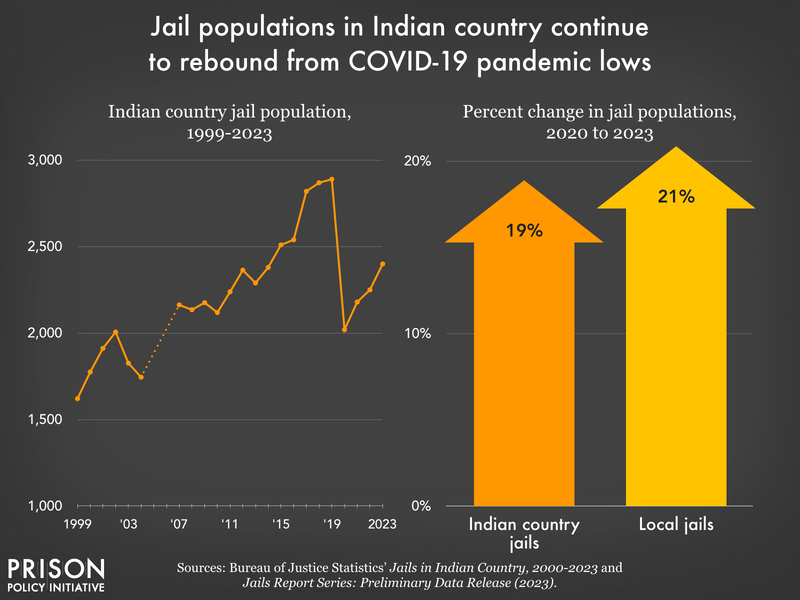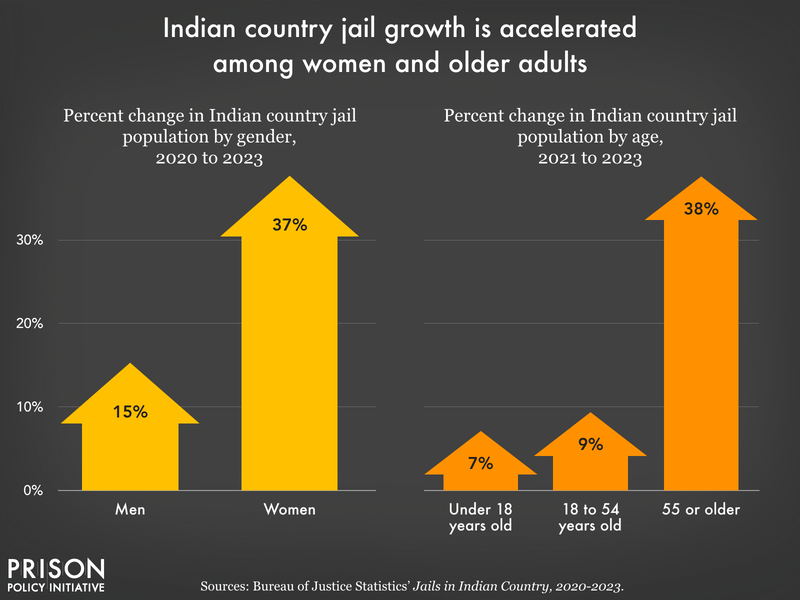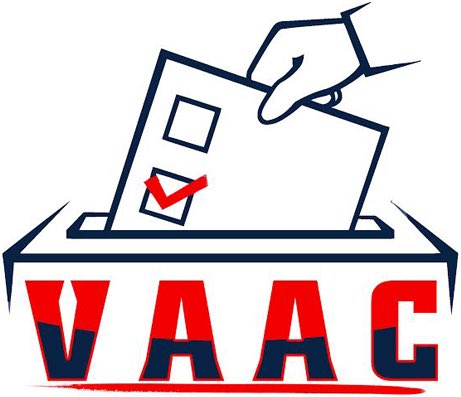This article was originally published by Prison Policy Initiative as “New, expanded data on Indian country jails show concerning trends extend to tribal lands,” authored by Emily Widra.
Native people are consistently overrepresented in the criminal legal system, accounting for only 1% of the total U.S. population but 3% of the incarcerated population.1 More specifically, the national incarceration rate of Native people is between two and four times higher than that of white people. Now, newly released data on jails in Indian country in 2023 provide more detail on this disturbing disparity: the Bureau of Justice Statistics (BJS) reports that, much like other jails across the country, Indian country jail populations are quickly bouncing back from the lows of the COVID-19 pandemic, and this growth has disproportionately impacted women and older adults.2
The Bureau of Justice Statistics (BJS) collects and publishes data about jail facilities on Native land separately — and with differing kinds of details — from other locally-operated jails across the country.3 In this iteration of the BJS survey on Indian country jails, the bureau collected new, more detailed information about offense types that are crucial to understanding the role of jails on Native land. They also reveal the troubling overuse of jails in response to non-criminal behaviors for youth and adults.

Indian country jail populations continue to rise after COVID-19
Jail populations across the country — including local and Indian country jails — dropped dramatically during the first year of the COVID-19 pandemic (30% from 2019 to 2020). This temporary decline was primarily explained by fewer people being arrested and booked into jails, as well as slowed court processes. In 2020, Indian country jails saw their first decline in total jail populations since 2013.4 But jail populations on Native land and across the country quickly surged after the first year of the pandemic: from 2020 to 2023, the Indian country jail population grew by 19%, consistent with the 21% growth seen in local jail populations nationwide over the same time period. However, from 2022 to 2023, other local jail populations only ticked up by 0.2%, while the Indian country jail population rose by 7% over that single-year period. In other words, while rebounds in local jail populations are slowing, Indian country jail populations are rising more dramatically.
Women and older adults increasingly incarcerated in Indian country jails
Much like other parts of the criminal legal system, the growth of the women’s and older adult populations in Indian country jails has outpaced the growth among men and younger adults.

Women: Native women are disproportionately affected by almost every part of the criminal legal system. They are incarcerated at higher rates than women of any other racial or ethnic group. Additionally, women account for a larger portion of the Indian country jail population than they do in other local jails across the nation: in 2023, women represented over a quarter (26%) of adults incarcerated in Indian country jails, but only 14% of people incarcerated in other local jails. In the last three years, the number of adult women in Indian country jails has grown 37%, compared to only 15% for men. Prior to the COVID-19 pandemic, however, we saw this dynamic in reverse: from 2016-2019, the number of women in Indian country jails only rose by 5%, while the number of men rose by 19%. This suggests an alarming shift in the incarceration trends of women in Indian country since the pandemic began, in line with the escalating incarceration rates of women throughout the nation.
Older adults: There are limited historical data on the age of people incarcerated in Indian country jails: the Bureau of Justice Statistics only began collecting and publishing this information in 2021. But over this three-year period, the rise in the number of older adults incarcerated in Indian country jails has been consistent with national trends: between 2021 and 2023, the number of people 55 and older in Indian country jails grew by 38%, while the number of adults under 55 years old only grew by 9%. To be sure, these populations are fairly small in scale — the overall population increase from 2021 to 2023 was 220 people — but any upward trend in the incarceration of older people is worth examining.
Jailing increasing numbers of older adults is part of a terrible national trend of policing unhoused people, poor people, people who use drugs and alcohol, and people with cognitive disabilities. Housing instability, chronic diseases, poverty, and substance use all disproportionately impact Native people, and older Native adults are particularly vulnerable to arrest, detention, and the serious and harmful consequences of incarceration.
New offense data reveals troubling trends on the overuse of jails in Indian country
This iteration of the Jails in Indian Country series provides more data than previous years, including more specific categorizations of the offenses for which people have been detained. These additional details are welcome, especially in light of the limited offense data among jail populations in general.5 In previous years, large portions of the Indian country jail population were lumped together in an “other unspecified” offense category. In 2022, for example, 29% of offenses reported to the BJS were “other unspecified,” and this catchall category has been as high as 37% of offenses in 2015. The inclusion of additional offense categories6 in the most recent survey significantly reduced “other unspecified” offenses to only 8% of the total. Additionally, this is the first iteration of the survey to include mental health and civil commitment holds, unspecified warrants, and status offenses for youth. These additions clarify what’s driving population growth in Indian country jails, while illuminating troubling trends about the overuse of these jails at the same time:
- Holds: The addition of the mental health and civil commitment holds7 in Indian country jails offers new insight into how often jails are used for questionable reasons. As we’ve argued before, detainers and “holds” contribute to unnecessary jailing, often keeping people in detention longer than necessary while awaiting psychiatric treatment or substance use treatment. Given the heightened prevalence of substance use disorders among Native people,8 the fact that people are in jail for mental health and civil commitment holds instead of receiving crucial healthcare reflects a serious dearth of treatment access on Native land.
- Unspecified warrants: About 20% of people in Indian country jails are detained for warrants without a specified offense. Many of these detentions are likely for bench warrants related to a “failure to appear” in court given the lack of specific offense data. We know that many court responses to “failure to appear” — including jailing — do not actually promote public safety and are often a misuse of resources. That’s because most people who “fail to appear” are not actually evading justice or threatening public safety: nationally, 87% of people who miss criminal court dates are facing “nonviolent” charges for property, drug, and public order offenses. Considering around a quarter of all cases are eventually dismissed, many people who miss court face punishment even though they would likely not be convicted of the alleged crime that brought them into contact with the system in the first place.
- Youth status offenses: More than 1 in 10 youth in Indian country jails are held for a status offense, or a “noncriminal act that is considered a law violation only because of a youth’s status as a minor.” This can include missing school, underage drinking, violating curfew, or running away. Native youth are disproportionately represented in status offenses across the country: in 2021, Native youth accounted for 4% of all status offense cases in juvenile court, while only 1.3% of the total U.S. population is Native. Status offenses carry serious consequences beyond jail detention: in 2021, 1,400 youth with status offenses were ordered to out-of-home placements including youth prisons, residential treatment, or group homes, separating them from family and community support systems.
- “Crimes against vulnerable populations:” In this iteration of the survey, a sample of jails in Indian country were asked to report if they had any admissions (but not the actual number of admissions) for “crimes against vulnerable populations,” including human trafficking, kidnapping, or elder abuse over the course of a single month (June 2023). The Bureau of Justice Statistics (BJS) characterizes these additional questions as responsive to the “interest expressed by Congress, tribal leaders, and federal agencies” to illuminate “the types of persons being held.” At least 17% of all Indian country jails report admitting at least one person for elder abuse and at least 6% of Indian country jails reported admitting someone for kidnapping, while no facilities reported admissions for human trafficking in that month.9 We hope to see further innovations in future iterations and in the larger national BJS surveys as well. For now, it’s hard to put these findings in any kind of context as there is little data on the prevalence of these types of victimization, nor any detail about the people held on these charges in Indian country facilities.
Conclusion
The inclusion of new, more detailed data on jails in Indian country offers the public important insights into the incarceration of Native people on tribal lands. While these trends mirror what’s happening in jails elsewhere across the country, having this level of detail is nonetheless crucial to understanding how the criminal legal system impacts Native people and communities.
More transparency must be provided in the coming years to better inform and target advocacy that reduces Native incarceration and confronts glaring racial disparities in the criminal legal system. This is especially true considering much of this data has only become available in recent years, unfortunately limiting the historical record of Native incarceration.
Ultimately, we hope the Bureau of Justice Statistics will continue and expand the collection and dissemination of such detailed information — including detailed offense and demographic data — for people in Indian country jails and jails across the nation.
Footnotes
- Throughout this briefing, “Native” refers to people identified by the Census Bureau as “American Indian/Alaska Native.” For a detailed discussion of how the flawed single-race categorization system obscures data on Native people throughout the criminal legal system, see our profile page on Native incarceration in the U.S. ↩
- “Indian country” — with a lowercase “c” — is a legal and administrative term used in federal law (18 U.S.C. §1151) to refer to Native lands, including reservations, trust lands, and restricted fee lands in order to define the boundaries of political and legal authority. For more detail about the differences between Indian country and other related terms, see this resource from the Center for Indian Country Development. ↩
- Jails in Indian country include all known adult and juvenile jails, confinement facilities, detention centers, and other correctional facilities operated by tribal authorities or the U.S. Department of the Interior’s Bureau of Indian Affairs (BIA). The BIA Office of Justice Services staffs and operates about a quarter of jails in Indian country, while the remainder are operated by Tribes. ↩
- All prior annual decreases in the Indian country jail population were relatively small, with drops of 3% (74 people) in 2013, 3% (57 people) in 2010, and 4% (81 people) in 2004. The largest annual population reduction in Indian country jails that we know of took place from 2002 to 2003, when the population fell by 9% (180 people). ↩
- The most recent offense-specific national jail data published by BJS was included in the 2002 Survey of Inmates in Local Jails. ↩
- These additional offense specifications are all in the “nonviolent and other holds” category, and include motor vehicle theft, malicious destruction of property/vandalism, status offense (for youth), warrants, and mental health/civil commitment holds. ↩
- Mental health and civil commitment holds are not criminal offense types; people detained for involuntary mental health holds may have underlying criminal charges, but are jailed because of their mental condition. Such holds can be extremely dangerous because jails are no place for people in a mental health crisis. “Civil commitment” is a broad category that most often refers to the court-ordered treatment of people with mental health or substance use disorders; however, many people end up locked up in jail rather than receiving the relevant treatment ordered by the court. Civil commitment can also refer to the post-prison confinement of people convicted of sex-related offenses in prison-like civil commitment facilities.
For more information about what mental health and civil commitment holds can look like, and the disastrous consequences of jailing people in crisis, see ProPublica’s investigation of Phillip Garcia’s 2017 death in Riverside County Jail.
↩ - Rates of substance use disorders — and alcohol use disorder in particular — are extremely high among American Indian or Alaska Native people: from 2015 to 2019, over 12% of Native people meet the criteria for a substance use disorder, compared to only 8% of white people and Black people. ↩
- Only 69 of Indian country jails eligible for survey participation (86%) responded to the relevant questions about “crimes against vulnerable populations.” Out of the 69 facilities that responded, 20% reported admissions for elder abuse and 7% reported admissions for kidnapping in June 2023. Applying these percentages to all 80 Indian country facilities participating in the Annual Survey of Jails in Indian Country, we find that 17% of jails reported admissions for elder abuse and 6% reported admissions for kidnapping. ↩
This article was originally published by Prison Policy Initiative as “New, expanded data on Indian country jails show concerning trends extend to tribal lands,” authored by Emily Widra
